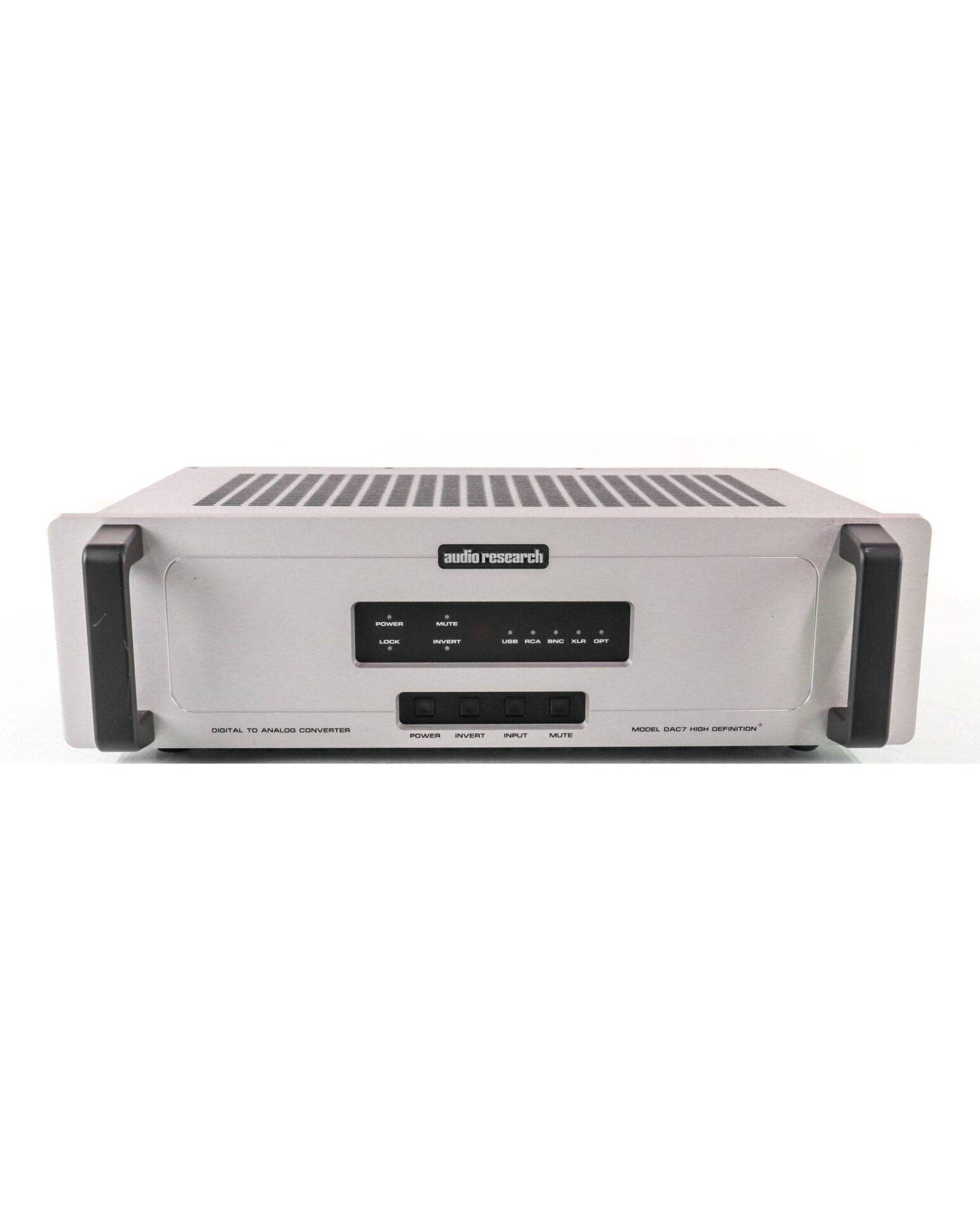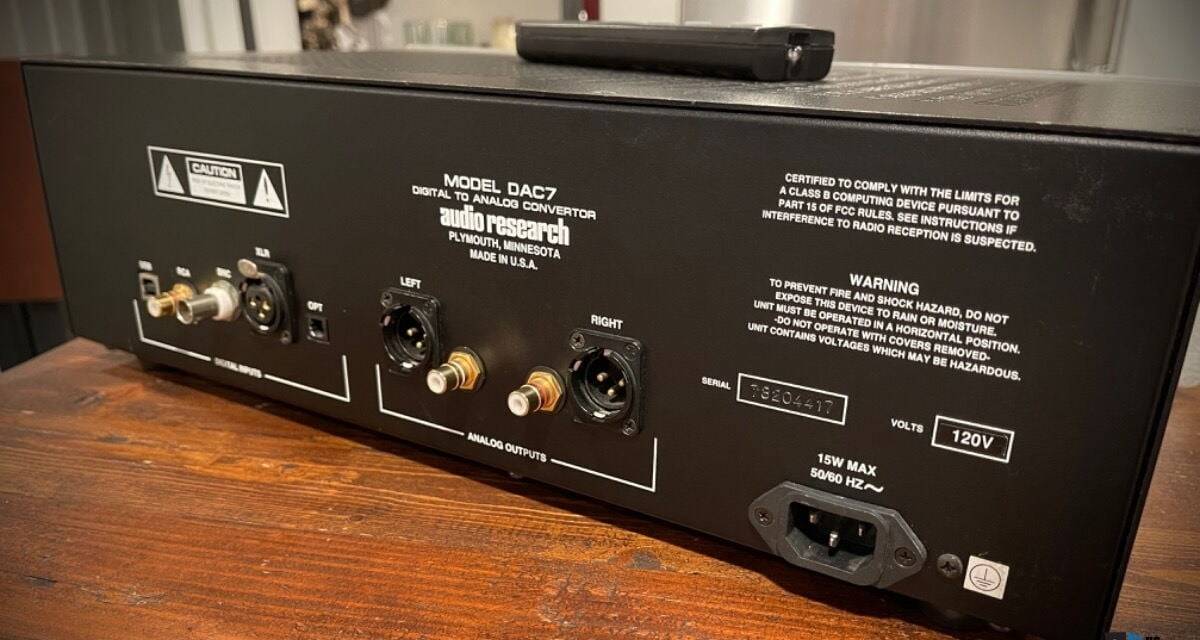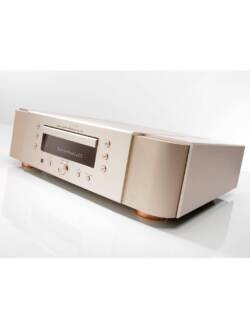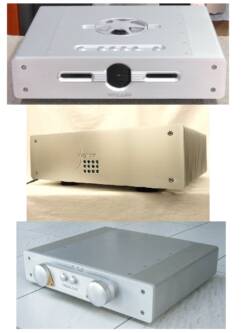Audio Research DAC 7
Original price was: R90,000.00.R24,000.00Current price is: R24,000.00.
Frequency Response:0.5-20,000Hz +0 -1dBDistortion:.03% 1kHz.
S/N Ration:BAL 114dBA below 20kHz. SE 110 dBA.
Phase Linearity:-Channel Separation:BAL 120 dB 1kHzResolution:24 BIT DAC.Output
Impedance:500 ohms BAL, 250 ohms
SE.Analog Output:1. Balanced XLR 5.2V RMS (+14.3dBv) max. 2.
Single-Ended RCA 2.6V RMS (+8.3dBv) max.
Digital Outputs:-Digital Inputs:
USB: Spec 1.0 to 2.0 16 BIT 32kHz to 48kHz, MAC or PC.
RCA: 75 ohm SPDIF 16/32 to 24/192.
BNC: 75 ohm SPDIF 16/32 to 24/192.
XLR: 110 ohm AES/EBY 16/32 to 24/192.
OPT: 660 NM TOSLINK FIBER 16/32 to 24/192
Power Requirements:100-135VAC 60Hz (200-270VAC 50/60Hz), 15 watts maximum (8 watts SLEEP.)
Other:
Jitter reduction: High-stability crystal-controlled re-clocking for all outputs.
Power supply: 2 transformers, 7 regulators.
Dimensions:19″ (48 cm) W x 5 ¼” (13.4 cm) H x 10″ (25.4 cm) D. Handles extend 1 ½” (3.8 cm) forward of the front panel.
Rear connectors extend ¾” (1.9 cm).
Weight:11.5 lbs. (5.2 kg) Net; 18 lbs. (8.2 kg) Shipping.
Description
Audio Research Dac7 (£2598)
Audio Research explains the role of the DAC7 thus: ‘With the growth of the iTunes culture and the increasing popularity of storing music on a hard drive, we were asked repeatedly to offer a USB DAC that could connect with Macs, PCs and servers to deliver a new benchmark in high resolution digital music playback’. It responded with a righteous solution that doesn’t pay mere lip service to iPods, servers and the like, because it’s an irresistibly musical device when used in a strictly traditional manner: fed by a CD transport.
So good was the performance when used with the Marantz CD12 transport and Quad’s CDP99 Mk II CD player that I approached the need to audition other sources grudgingly. Yes, I have a hundreds of tracks on my notebook PC and mobile phone, but the test was my son’s computer – his primary source of music. I had to smile toward Minnesota when he plugged in his Dell Inspiron 1525 notebook (cost: under £400) and had it playing within 30 seconds. Audio Research may mean purist audiophilia to most of us, but it has learned the ways of the young: the DAC7 is no old fart’s toy.
But then I am an old fart, and couldn’t give a toss about connecting my primary sound system to anything with a USB output. My attitude toward servers is utterly dismissive: I’m not so infirm that I can’t manage to feed my player a disc at a time. In fact, I enjoy the act of selecting a title, opening the jewel box, slipping in the disc. I get enough ‘mouse-ercise’ working for a living. So forgive me if this review concentrates on the DAC7’s role in a high-end two-channel context. Suffice it to say, it sounds too good for the majority of material which will enter via its USB socket.
NOTHING NEGLECTED
While accommodating USB, Audio Research did not neglect the more familiar inputs. This unit is genuinely flexible, and you’d have to be a psycho-grade audiophile – eg, one of those Japanese whack-jobs who uses a different CD player for CDs from each record company – to require more inputs. The USB input covers 1.0 and 2.0 16-bit material, from 32kHz to 48kHz, and addresses both MAC or PC. The others all handle 16/32 to 24/192 and include: 75ohm RCA via phonos, 75ohm BNC, 110ohm AES/EBU through XLRs and Toslink for optical (I tried all but the BNC). Analogue outputs include single-ended RCAs and balanced XLRs, the latter feeding the McIntosh C2200 preamp, into the MC2102, driving Nola Vipers [see p32] and LS3/5As.
Matching the look of ARC’s preamplifiers and measuring 480 x 134 x 254mm (whd), the DAC7 features four buttons on the front panel for Power, Mute, Invert and Input Select. The remote, though, operates those commands as well as the Play/Pause, Stop, Track Up and Track Down functions of a USB device, demonstrating with assuredness that the USB socket isn’t merely paying lip-service to the technology. The DAC7 uses green LED tell-tales to let you know the signal has been locked in, as well as indicating Power-on, Mute, Invert and which source is selected.
If you want valves, look elsewhere. The DAC7 is a fully-balanced, solid-state processor employing a direct-coupled FET output stage and regulated power supplies, with seven stages of regulation. ARC fitted separate audio and digital power transformers, mounted on PCBs made of the same material as used in the Reference models. Inside, there’s a 24-bit/192-capable Burr-Brown DAC which uses ‘passive I/V conversion for best sonics’.
GOING BACK IN TIME…
Set-up was of the no-brainer variety, especially the aforementioned use with a computer. The best sound was all-balanced, the Marantz CD12 absolutely loving the ARC DAC, sounding sweet and warm and rounded, a big, fat Barolo of a sound – rich, sophisticated and full of nuance. Even with seemingly creaky material, the DAC7 seduced such sounds out of conventional CDs that I wish it had been available in time to curtail the format war of SACD vs DVD-A. Yeah: that good, if not capable of multichannel sound like those doomed formats.
After the usual run of Keb’ Mo’, Eva Cassidy and other warm-up discs, I slipped in CDs from Louis Armstrong’s The Complete Hot Five and Hot Seven Recordings (which date from the 1920s). It wasn’t the well-preserved, familiar tracks that showed what the ARC could do, but the rare cuts which were probably culled from well-worn 78s. I swear I heard front-to-back layering of cornet and piano on the ‘rare’ take of ‘Drop That Sack’, while the staccato of Armstrong’s fast fingering belied 80-plus years of recording technology.
Auditioning what may be a state-of-the-art DAC with recordings so old as to warrant the term ‘antediluvian’ isn’t a case of being ironic: the DAC7’s entire raison d’être is resolution, fidelity and getting closer to the music. As with the best LP spinners, which allow you to ignore the surface noise on second-hand treasures that never saw a carbon-fibre brush, the DAC7 somehow renders utterly unimportant the 78rpm crackles not stripped away in the remastering. While those fortunate enough to own the original 10in shellacs wouldn’t touch this with a 10ft tonearm, I for one was pleased to hear Armstrong’s ‘Muskrat Ramble’ sounding, oh, 30 years younger than it actually is.
…AND COMING UP TO DATE
Turning the dial ahead eight decades, and last year’s live One Man Band from James Taylor, recorded sympathetically and with great sensitivity, also showed how far ‘Red Book’ CD has come in a quarter-century. A chiming character to the piano, a richness to the acoustic guitar, a warmth to a voice I’ve heard so many times it chokes me – including a live gig back in ’71 – complemented the real giveaway with live recordings: applause that didn’t sound like it needed a bowl, cold milk and sliced banana.
Regardless of source – Marantz transport, Quad CD player, Dell notebook – the DAC7 possesses an air of Good Samaritan. It’s as if the designers built in a sense of William Zane Johnson’s high-end pater familias status, some sort of guiding force encouraging the music not to sound digital. And that’s a Good Thing.
VERDICT
It’s been ages since stand-alone DACs inspired interest, but the times forced a revival. ARC has addressed – rather than embraced – the age of servers et al with a DAC as sublime as any I’ve heard, as close as it gets to my hot-rodded Marantz DA12. What’s so surprising is the DAC7’s price. As for CD feeds, I can’t name another DAC which I would rather use.
| April 1, 2009
Audio Research DAC7 Digital-to-Analog Converter
Physicality The DAC7 ($3495 USD) looks similar to most of the preamp-sized Audio Research components you’ve seen. Not some mite-sized product that might make you think it’s a compromised design or a mere add-on, the DAC7 is a full-sized model measuring 19″W x 5 1/4″H x 10″D, weighing 11.5 pounds, and boasting an impressive array of features. The DAC7 has five digital inputs: USB, XLR, RCA, BNC, and optical on a TosLink connector. On the front panel are buttons for Power, Mute, Invert, and Input. According to ARC, the supplied remote control not only duplicates the functions on the front panel, but uses USB’s HID protocol for control of any USB-based device connected to the DAC7: Play/Pause, Stop, Track Up/Down. ARC states that “The DAC7 is a fully balanced solid-state design utilizing a new direct-coupled FET output stage and generous regulated power supplies with seven stages of regulation. Separate audio and digital power transformers are mounted to boards made of the same material as our Reference products. The Burr-Brown DAC is 24/192 capable and utilizes passive I/V conversion for best sonics.” The USB input, however, is limited to 16-bit/48kHz signals — perhaps an Achilles’ heel for those with systems that transmit signals only via USB. The rest of the inputs are capable of processing full 24/192 signals.
System I used the Audio Research DAC7 with the following system: Loudspeakers were Thiel CS2.4SEs or EgglestonWorks Diannes. Power amplifiers were a pair of Classé Audio Omega Omicron Monos fed by a Simaudio Moon Evolution P-8 preamplifier. The source component was an Apple MacBook connected to the DAC7 via USB. Cabling and power conditioning consisted of the following Shunyata Research products: Aurora-IC interconnects, Aurora-SP speaker cables, Hydra V-Ray power conditioner, and Anaconda Helix Alpha/VX, Python Helix Alpha/VX, and Taipan Helix Alpha/VX power cords. Sound Attempting to describe how the DAC7 sounded compared to other digital products I’ve recently heard reminded me of how confounded I was the first time I heard Dynaudio’s Esotar2 tweeter. In late-night listening sessions about five years ago, I was trying to reconcile an apparent contradiction in what I was hearing from Dynaudio’s Confidence C2 floorstanding loudspeaker: On the one hand, the Esotar2 presented high-frequency information in a fashion as detailed as I’d ever heard. There was no apparent lack of finely delineated resolution, no truncated frequency response — on the contrary, it seemed quite extended at the top end — and I could detect no compromise in fidelity when listening to live recordings with ample air around the performers. And yet, the Esotar2 was more comforting and relaxing to listen to than most of the metal-dome tweeters I was used to. That experience made me revisit not only my preconceptions about metal-dome vs. soft-dome tweeters, but also the way music itself is realized through technology: Sometimes, what seems to be the conventional wisdom about some aspect of audio gear is just plain wrong. I’d been under the impression that the soft-dome Esotar2 wasn’t capable of the ultimate levels of detail and transparency attained by some of the best metal domes I’d heard. But it turned out to be fantastic in those regards. The ARC DAC7, in some very musically relevant ways, is cut from the same cloth as the Esotar2. The DAC7 didn’t knock me out with whiz-bang frequency extension and sonic fireworks — in other words, it didn’t shine a spotlight on all the high-frequency details present in my best recordings — and yet it permitted that detail to make it to my ears with its own combination of sonic ease and crystalline clarity. Nor did the DAC7 propel music along at an unnatural clip. It didn’t sound “slow” or “fast” or any such thing, but had a free-flowing character that made me want to listen through it without dissecting the music. In terms of tonal balance, the DAC7 never approached brightness or hardness unless the recording itself possessed those characteristics; instead, it had the typical, good-natured ARC sound. But I did feel that it occasionally brought out the tone colors of musical selections better than other digital sources I’ve heard — a very pleasant characteristic, if perhaps a slight departure from absolute neutrality. Listening to the DAC7 also made this music lover pleasantly at home with his music collection. This last part, in my experience, is what, more than anything else, leads to long-term satisfaction with a product. Vivaldi’s third La Stravaganza concerto, Op.4 No.3 (CD, Channel Classics 19598, via the demo CD Arabesque by Crystal Cable), performed by Rachel Podger and Arte Dei Suonatori, sounded at once vibrant and brimming with energy, but was never in any way piercing or grating, even at very enthusiastic output levels. This recording is fantastically clear, with excellent timing and snap. In many ways, it has sounded good, retaining its overall level of recorded excellence, through every system I’ve tried it with — but it was perhaps most persuasive through the DAC7-anchored system. It sounded luxurious, with colorful tone and perfectly rhythmic pacing — just what I love to hear after a long day’s work. Mussorgsky’s Pictures at an Exhibition, specifically The Great Gate at Kiev, performed by Eiji Oue and the Minnesota Orchestra (CD, Reference RR-79CD, again via the Crystal Cable demo disc), sounded huge, powerful, and open. Highs were sparkling, with enough of the expertly captured decay to let me sense the scale of the orchestra as it sat within its physical surroundings. The bass was magnificent; I easily felt and heard its powerful, deeply planted foundation. This track gave me goose bumps, again played back at levels that would approach those of a live performance. Heard through the DAC7, soprano Marianne Mellnäs’s incredible rendition of “O Holy Night” was just as impressive. (I found this track on an unnamed sampler I picked up in Munich about five years ago; it’s available on Cantate Domino; SACD, Proprius 7762.) When the chorus comes in about a minute into the carol, the scale of the venue is revealed — I heard outstanding height and depth in a truly three-dimensional soundstage. The air that surrounded the performers was almost tactile — the DAC7 produced this beautiful performance with as much fidelity as I’ve heard. The organ was also rendered with perfect tone and pitch, and with great power in the low frequencies to boot. Karan Casey’s honest vocal on “An Buachaillín Bán,” from her Songlines album (CD, Shanachie 78007), seemed to have more of that perfectly rendered tone color described above. This is intrinsic to this recording, meaning the DAC7 was revealing more information to me. But the DAC7 also imparted more clarity than I’m used to hearing in the upper midrange and lower treble, which helped give Casey’s voice a pleasing beauty throughout her range. Perhaps the best way to describe what I heard, as the DAC7 revealed the inner beauty of vocals and beautifully fleshed out the sounds of stringed instruments, is the phrase “golden tone.” Again, this was due to the revealing nature of the DAC7, specifically throughout the midband. I guess at this point it’s obvious that I thoroughly enjoyed listening to music with the DAC7 in my system. After recently hearing several top-notch DACs, many via USB but also via FireWire, optical, and AES/EBU, I’ve come to a conclusion: The best DACs differ most in the very highest frequencies. I also have a new rule of thumb: If a DAC doesn’t get the midrange or the low end right, discard it immediately from consideration. But the highs can be more a matter of taste. Take, for instance, Ultra Audio’s Product of the Year for 2008, the Weiss Minerva digital-to-analog converter ($4500). As operated through its FireWire input, it still produces the most transparent highs I’ve yet heard from my system. In my review, I stated that “the high frequencies seemed to extend into infinite darkness without any harshness or grain.” By comparison, the DAC7’s reach didn’t seem quite “infinite.” However, what it reproduced right below the uppermost frequencies of the audioband was perhaps a touch more jammed with information than what the Minerva could muster. This is a slippery slope: I realize that if the DAC7 were highlighting the mid-treble at the expense of ultimate high-frequency detail, recordings with a lot of information in the lower treble would perhaps sound better. However, it could just as easily be that the DAC7 was simply better in the mid-treble, the Minerva more transparent and more extended in the upper treble. It’s hard to suss this out with absolute certainty, but either way, I can tell you this: If you value ultimate fidelity right to the upper limit of human hearing, the Weiss Minerva might be the best choice money can buy. On the other hand, I’m not so sure I’d pick it over the ARC DAC7 for the bulk of the recordings I listen to. In fact, I can’t imagine preferring anything to the DAC7 — including the Minerva — when listening to the Vivaldi concerto mentioned above. Everyone should have such problems. Which leads me to repeat: The best DACs I’ve heard seem to primarily differ in their presentation of high-frequency detail. It was hard to fault the Weiss Minerva or the ARC DAC7 in the midrange or the bass — both easily outclassed the Stello DA220 Mk.II, which has been my reference for the past year. But in the treble, there were differences that could easily sway a listener one way or the other. In short, both are strongly recommendable products, if perhaps for different listeners and different systems. Conclusion The Audio Research DAC7 continues the tradition of fantastic digital components from a company mostly known for its power amplifiers and preamplifiers. It is a beautiful-sounding component that captures the gestalt of finely recorded music. It might not be the absolute champion in terms of high-frequency transparency and upper-treble extension, but I’m not sure how musically relevant those areas are to the majority of music selections recorded at 16-bit/44.1kHz. What it offers in the upper midrange and lower treble set it apart from the pack, and I suspect that the way it presents music as a whole would make it an ideal choice for most readers of Ultra Audio. I can’t imagine the DAC7 sounding bad in any system; its strengths should mate well with most of the finest setups I can think of. Whether or not the DAC7 can be described as a “reviewer’s tool” is not the point. I’ve found that many listeners simply don’t want that type of intensely detailed sound. What defines the DAC7’s worth is what it would do for most music lovers, and that I’m sure of: It would enhance their enjoyment of their music collections. That the DAC7 comes from one of the truly first-class companies in all of high-end audio is a bonus — you’re pretty much assured of a good ownership experience. What else can I say? ARC’s DAC7 is a clear winner that every audiophile should get to hear. . . . Jeff Fritz Audio Research DAC7 Digital-to-Analog Converter |









